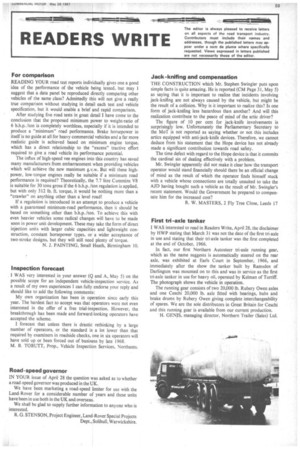For comparison
Page 61

If you've noticed an error in this article please click here to report it so we can fix it.
READING YOUR road test reports individually gives one a good idea of the performance of the vehicle being tested, but may I suggest that a data panel be reproduced directly comparing other vehicles of the same class? Admittedly this will not give a really true comparison without studying in detail each test and vehicle specification, but it would enable a brief and rapid comparison.
After studying five road tests in great detail I have come to the conclusion that the proposed minimum power to weight-ratio of 6 b.h.p. /ton is completely worthless, especially if it is intended to produce a "minimum" road performance. Brake horsepower in itself is no guide at all for heavy commercial vehicles and a far more realistic guide is achieved based on minimum engine torque, which has a direct relationship to the "excess" tractive effort required to give a road vehicle its performance potential.
The influx of high-speed vee engines into this country has saved many manufacturers from embarrassment when providing vehicles which will achieve the new maximum g.v.w. But will these highpower, low-torque engines really be suitable if a minimum road performance is required? Theoretically, the 7.7 litre Cummins V8 is suitable for 30 tons gross if the 6 b.h.p. /ton regulation is applied, but with only 312 lb. ft. torque, it would be nothing more than a "crawler" on anything other than a level road!
If a regulation is introduced in an attempt to produce a vehicle with a guaranteed minimum-road performance, then it should be based on something other than b.h.p. /ton. To achieve this with even heavier vehicles some radical changes will have to be made soon in power unit development. These may take the form of direct injection units with larger cubic capacities and lightweight construction, constant horsepower types, or a wider acceptance of two-stroke designs, but they will still need plenty of torque.
N. J. PAINTING, Small Heath, Birmingham 10.












































































































